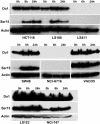Analysis of P53 mutations and their expression in 56 colorectal cancer cell lines
- PMID: 16418264
- PMCID: PMC1327731
- DOI: 10.1073/pnas.0510146103
Analysis of P53 mutations and their expression in 56 colorectal cancer cell lines
Abstract
A comprehensive analysis of the TP53 gene and its protein status was carried out on a panel of 56 colorectal cancer cell lines. This analysis was based on a combination of denaturing HPLC mutation screening of all exons of the p53 gene, sequencing the cDNA, and assessing the function of the p53 protein by assaying the induced expression of phosphorylated p53 and p21 after exposing cells to gamma-rays. In a few cases where there was no production of p53 message nor evidence of functional p53 protein, all of the p53 exons were sequenced directly. Thirteen of the 56 cell lines had functional p53, 21 lines had missense mutations (one of which made no detectable protein), 4 lines produced no p53 transcripts, and the remaining 18 lines carried truncating TP53 mutations. Thus, our results showed a relatively high frequency of TP53 mutations (76.8%) in our cell lines, with almost half of the mutations being truncating mutations. This is a rather higher frequency of such mutations than usually reported. Of the 18 cell lines with truncating mutations, 12 had detectable truncated protein based on Western blot analysis, whereas no protein was detected in the remaining 6 cell lines. Our data provide a valuable source of TP 53 mutations for further studies and raise the question of the extent to which truncating mutations may have dominant negative effects, even when no truncated protein can be detected by standard methods.
Figures




References
-
- El-Deiry, W. S. (1998) Semin. Cancer Biol. 8, 345–357. - PubMed
-
- Sigal, A. & Rotter, V. (2000) Cancer Res. 60, 6788–6793. - PubMed
-
- Lang, G. A., Iwakuma, T., Suh, Y. A., Liu, G., Rao, V. A., Parant, J. M., Valentin-Vega, Y. A., Terzian, T., Caldwell, L. C., Strong, L. C., et al. (2004) Cell 119, 861–872. - PubMed
-
- Olive, K. P., Tuveson, D. A., Ruhe, Z. C., Yin, B., Willis, N. A., Bronson, R. T., Crowley, D. & Jacks, T. (2004) Cell 119, 847–860. - PubMed
-
- Melino, G., Lu, X., Gasco, M., Crook, T. & Knight, R. A. (2003) Trends Biochem. Sci. 28, 663–670. - PubMed
Publication types
MeSH terms
Substances
LinkOut - more resources
Full Text Sources
Other Literature Sources
Medical
Research Materials
Miscellaneous

